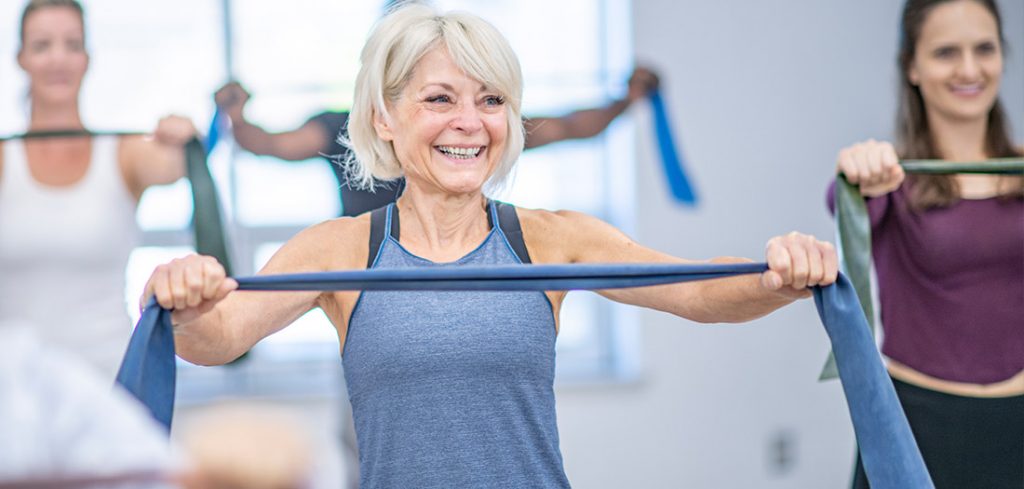7 Things We Learned About Fitness in 2019

Exercise science researchers published a number of important findings over the course of 2019. While the seven studies referenced below are not a comprehensive review of everything that was published over the past year, they do provide some insights into new ways that exercise can be used to help your clients, especially those in the later years of the human aging process.
1. Aerobic Exercise Could Help Improve Memory in Older Adults
In a study published in the Journal of Applied Physiology, Nutrition and Metabolism, a team at McMaster University found that older adults who participated in high-intensity interval training (HIIT) workouts experienced up to 30% improvements in short-term memory, while participants in moderate-intensity exercise did not experience the same outcomes. The study group included older adults between the ages of 60 and 88 who exercised three times a week for 12 weeks.
“It’s never too late to get the brain benefits of being physically active, but if you are starting late and want to see results fast, our research suggests you may need to increase the intensity of your exercise,” says Dr. Jennifer Heisz, an associate professor in the department of Kinesiology at McMaster University and lead author of the study.
2. The Benefits of Cardiac Rehabilitation for Older Adults
French researchers reviewed the effects of cardiovascular exercise on older adults in an attempt to compare the effects of a cardiac rehabilitation program for participants divided into groups of individuals less than age 65, those between 65 and 80 years old and those over the age of 80. The study, published in the Canadian Journal of Cardiology, followed more than 700 participants over the course of two years and found that exercise improved capacity in all groups, regardless of age, and those who started exercising, even in their “later years” were able to experience important benefits.
“Older adults who are eligible for cardiac rehabilitation have a decreased likelihood of receiving a referral compared to their younger counterparts,” explains Dr. Codie Rouleau, a study author and an adjunct assistant professor in psychology at the University of Burgundy Franche-Comte in Dijon, France. “The present report may serve as a catalyst for clinicians to recognize that older adults with coronary artery disease stand to benefit if referred and given the opportunity to participate.”
3. Exercise Can Improve the Mental Health of Older Adults
It is well known that exercise is good for the physiological systems of the body regardless of age; this past year research published in the American Journal of Physiology-Cell Physiology suggests that exercise can help support mental health as well by reducing the risk of depression in older adults. Previous research has shown that exercise can change the levels of neurotransmitters that can affect overall mental health. This study sought to answer the question about whether sarcopenia—the loss of muscle mass—that occurs during aging would affect the ability to use exercise as a treatment for depression in older adults. The study concluded that men over the age of 65 who participated in high-intensity workouts designed to increase muscle mass experienced mental health benefits over the course of the 12-week study period.
4. Exercise Could Improve Cognitive Function in Older Adults
A team from the University of Iowa found that even a single bout of exercise can have a change on brain function in older adults. In experiments that included exercise, brain imagery and a memory test, the study participants showed that exercise can help improve memory in both the short term and over the long run. Brain scans were able to show how one bout of physical activity could have an immediate impact on the function of the organ, which could help develop further understandings of the relationship between exercise and recall memory. This provides further evidence that regular physical activity can not only change the physiological functions of the body but could also help improve cognitive performance of the brain, even during the latter years of the aging process.
5. Position Statement on Resistance Training for Older Adults
In 2019, the National Strength and Conditioning Association updated their position statement on the benefits of resistance training for older adults. The position statement relies on evidence published in peer-reviewed journals to encourage older adults to participate in resistance training for a variety of health benefits. Resistance training can help older adults increase lean muscle mass, improve functional strength for activities of daily living and help enhance overall quality of life.
“The goal of this position statement is to a) help foster a more unified and holistic approach to resistance training for older adults, b) promote the health and functional benefits of resistance training for older adults, and c) prevent or minimize fears and other barriers to implementation of resistance training programs for older adults,” according to a statement released by the National Strength and Conditioning Association.
6. Exercise Guidelines for Cancer Survivors
Cancer is a horrible disease that can affect people of all ages and, while there are many benefits of exercise, exactly how exercise influences the human body as it is fighting cancer is not completely understood. For this reason, a team of researchers at the University of British Columbia developed a series of guidelines for how to exercise with cancer. The guidelines were published in Medicine & Science in Sports & Exercise. In general, the guidelines recommend that cancer survivors perform both aerobic and resistance exercise for at least 30 minutes three times a week.
“Exercise has been regarded as a safe and helpful way for cancer survivors to lessen the impact of cancer treatment on their physical and mental health, but the precise type and amount of exercise to treat the many different health outcomes related to cancer treatment hasn’t been clear,” according to Dr. Kristin Campbell, the study’s lead . When working with cancer survivors it is important to understand the unique needs of the individual client in order to create and implement a personalized exercise program built around the continued treatment plan, client goals, daily energy levels, and availability. Including the client in the exercise program design process and checking in regularly for discomfort, treatment changes, and enjoyment is a great way to keep the exercise program centered on the client and to view them as a resourceful part of the client trainer relationship
7. Your Social Media Posts Can Track Your Exercise Habits
Over the past year, researchers at the Boston University School of Public Health used artificial intelligence to go through exercise-related tweets from Twitter users all over the United States. The researchers analyzed the language posted in the tweets about exercise in an attempt to identify how different users feel about different kinds of exercise. The study authors reviewed more than 1.3 million tweets posted by more than 480,000 individual users to identify habits and perceptions related to exercise. Their findings were published in the BMJ Open Sport & Exercise Medicine.
“By understanding differences in how people are exercising across different communities, we can design interventions that target the specific needs of those communities. In the future, social media and other digital data could help create new interventions and policies informed by the habits of the communities we are trying to serve,” explains lead study author Dr. Nina Cesare.


